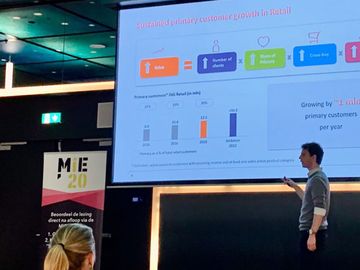
WUA launches new rankings: The Digital CX Score and the Digital Sales Score
Big and quite exciting news. In the coming months, WUA will phase out the Web Performance Score for new studies: the aggregate score for digital customer experience and digital performance. This week we’re already publishing new studies with not one, but two rankings. These new overall scores are called the Digital CX Score and the Digital Sales Score. A big change, it seems. In this article we will walk through our choices, considerations, and backgrounds.
Farewell to the Web Performance Score
If you’re reading this, your company or organization has probably featured in one of the WUA rankings of the many different digital customer experience studies that we’ve carried out over the past ten years. Sometimes there has been constant a market dominance of 1 player in the rankings, sometimes you were the number one and celebrating, sometimes a winner was declared based on decimal points.
In English, WUA has always referred to our model as the Digital Sales Scan Model, but for our Dutch (and some other) studies, we always used the term Web Performance Model. Similarly, the final score was always referred to as the Web Performance Score in The Netherlands and some other countries, whereas in the UK and the US we used the term Digital Sales Score. To create consistency and to improve the way in which we report website performance, we’ve overhauled the way in which we calculate the scores and determine the ranking. From now on, the overarching score (Web Performance Score, or in the UK and US the Digital Sales Score) will be divided into two scores, the Digital CX Score and the Digital Sales Score, because it no longer tells us enough to offer a complete picture of what is happening within a market. During the orientation process, a website needs to be found. This is crucial. However, a website also needs to convince visitors and generate preference and conversion based on an excellent customer experience. These conditions and nuances come together in the new Digital Sales Score and in the new Digital CX Score.
New: Digital Sales Score and the Digital CX Score
From September 2016, WUA has been using the Digital Excellence Monitor to show what happens if we remove the sales performance elements (Preference and Findability) from the studies, and zoom in on the customer experience themes (Look & Feel, Product Offer, and Brand). Different players are in the lead in the rankings: it wasn’t the players with the highest brand awareness or the largest SEA/SEO budgets who were at the top, but the players with the highest scores on the customer experience themes.
With the two scores, WUA gives more justice to two sub-areas that are of great importance when it comes to digital customer journey research. We offer more specific insights into the market performance of websites, and we paint a better picture of the customer experience level. All based on the familiar Web Performance Model (or Digital Sales Model in some countries), which we will now refer to as the WUA Digital Sales Model.
How we calculate the new Digital Sales Score
With this new score, WUA shows our vision on online performance. The Digital Sales Score is mainly based on the Preference percentage, and partly on the Conversion and Preference score. In the rankings, we show all providers who are found by 5% of respondents or more in our studies. You will find a clarification of the “ingredients” of the Digital Sales Score.
Findability
We define Findability as the percentage of respondents who evaluate a website during their orientation on a particular product. This could be via a search engine or by entering the URL directly.
Conversion
In the world of WUA, Conversion means: Preference percentage divided by Findability percentage, i.e. to what extent is a website able to convince website visitors to choose this website or provider?
Preference
Because consumers find and evaluate multiple websites during their customer journeys, we ask them which website would have their final Preference. We do this with the question: “Which website would be your number 1 if you were to buy or apply for product X?” After all: if a website succeeds in attracting and keeping a visitor on their website for a longer period of time, then the intention is to have this visitor decide to purchase a product or service. Preference is expressed using an absolute percentage.
Preference score
We do not express preference score using a percentage, it is a “school grade” for Preference. You get more points for a #1 position in the study than you would for a #2 or #3 position. If providers A and B are listed as the number 1 the same number of times (i.e. have equal scores on preference percentage), and provider A has a higher percentage of respondents who put this party in second place than provider B, provider A gets a higher preference score. Theoretically, it is possible for two parties to have the same percentages for conversion, findability, and preference, but to end up with different Digital Sales Scores.
Correcting for love brands and dominators
We correct the Digital Sales Score for very low and very high findability. Parties with low findability and high conversion receive “penalty points”, often these are niche players in a market or they’re love brands for example. Such parties are often visited by a specific group, thus counting on a loyal “fans”: this distorts the Preference percentage. Parties with high findability and high conversion are doing very well and in turn, receive “bonus points”.
Digital Sales Score suits WUA’s vision of digital performance
The goal of an online sales journey is ultimately to sell as many products and/or services as possible. Findability can be partly optimized (SEO), partly purchased (SEA), and partly claimed with your brand through the years (top-of-mind brand awareness, direct traffic). You can optimize the conversion percentage by improving your website (Look & Feel), product (Product Offer), and/or company awareness and reputation (Brand).
Preference is the result of all the above, you cannot tweak that. At WUA, our view is that the company that gets the highest preference should be the winner. And we believe that you can be better at this better with a very good website (high conversion) that gets less traffic (findability) than a moderate website (low conversion) that gets a lot of traffic. We have also included “market potential” in this new score, in the form of Preference Score.
How we calculate the Digital CX Score
The Digital CX Score is a representation of the total experience on the website, based on questions about the themes of Look & Feel, Product Offer, and Brand. Think about, for example, the quick and clear presentation of the product offer on the website and the trust people have in the company behind the website.
The score consists of a weighted average of these components, where components that have more impact on the final preference carry more weight. For example, our analyses have shown that Product Offer and Brand are more important in generating preference than Look & Feel.
These new CX and Sales scores sound nice, but what about the benchmark?
Due to changing consumer behavior and the changing expectations associated with this, the digital customer experience is also constantly changing. WUA’s approach takes this into account, and we are continuously improving with small steps. Once a year we take a somewhat larger leap as we have now. However, our mission remains the same: every day we are working to build the largest and best digital customer experience benchmark in the world.
Although scores and the way in which we publish overall rankings will change, benchmarking remains possible. Because we can convert the Web Performance Score from our “old” research into the new Digital Sales Score, which means benchmarking remains possible. For the customer experience theme scores, a 1-1 comparison will remain possible.


